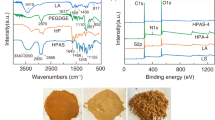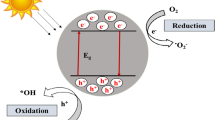Abstract
Copolymers of polyvinyl butyral (PVB)/polyethylene glycol diacrylate (PEGDA) were prepared by free radical polymerization using gamma irradiation. The physical properties such as gelation, swelling and the thermal behavior of the prepared PVB/PEGDA copolymer were investigated as a function of molecular weight of PEGDA. The thermal behavior of blank PVB (PVB/PEGDA)-575 and (PVB/PEGDA)-750 copolymers as a function of absorbed dose up to 100 kGy was determined using thermogravimetric analysis (TGA) and differential scanning calorimetry (DSC). The thermal stability of the prepared copolymers was improved by gamma irradiation, PEGDA and the increasing of PEGDA molecular weight. Two textile dyes, Diamine Fast Scarlet GG and Direct Pink 3B, were used as model anionic dyes. The adsorption of PVB/PEGDA hydrogels of different molecular weights was investigated towards the two anionic dyes by the batch equilibrium method. The adsorption capacity of the copolymers was evaluated as a function of initial dye concentration, different molecular weight, and time. The equilibrium data obtained in batch experiments were correlated to Langmuir and Freundlich isotherm equations. Results showed that the adsorption of Direct Pink 3B fitted well to the Langmuir model, while the adsorption pattern of Diamine Fast Scarlet GG followed the Freundlich isotherm, which suggests heterogeneity of the adsorption sites on the copolymer. Thermodynamic data revealed spontaneous exothermic processes and was a physisorption reaction. Our results demonstrate that the PVB/PEGDA copolymer is very promising for removing organic dyes from waste water.











Similar content being viewed by others
References
Sanghi R, Bhatttacharya B, Singh V (2002) Cassia angustifolia seed gum as an effective natural coagulant for decolourisation of dye solutions. Green Chem 4:252–254. doi:10.1039/b200067a
Guendy HR (2010) Removal of Azo reactive, direct dyes from wastewater using different coagulants at different pH. J Appl Sci Res 6:956–963
El-Sigeny S, Mohamed SK, Abou Taleb MF (2014) Radiation synthesis and characterization of styrene/acrylic acid/organophilic montmorillonite hybrid nanocomposite for sorption of dyes from aqueous solutions. Polym Compos 35:2353–2364. doi:10.1002/pc.22902
Baseri JR, Palanisamy PN, Sivakumar P (2012) Comparative studies of the adsorption of direct dye on activated carbon and conducting polymer composite. J Chem 9:1122–1134
Kornaros M, Lyberatos G (2006) Biological treatment of wastewaters from a dye manufacturing company using a trickling filter. J Hazard Mater 136:95–102. doi:10.1016/j.jhazmat.2005.11.018
Zahrim AY, Tizaoui C, Hilal N (2011) Coagulation with polymers for nanofiltration pre-treatment of highly concentrated dyes: a review. Desalination 266:1–16. doi:10.1016/j.desal.2010.08.012
Zhao W, Wu Z, Wang D (2006) Ozone direct oxidation kinetics of cationic red X-GRL in aqueous solution. J Hazard Mater 137:1859–1865. doi:10.1016/j.jhazmat.2006.05.032
Capar G, Yetis U, Yilmaz L (2006) Membrane based strategies for the pre-treatment of acid dye bath wastewaters. J Hazard Mater 135:423–430. doi:10.1016/j.jhazmat.2005.12.008
Liu C, Wu J, Chiu H et al (2007) Removal of anionic reactive dyes from water using anion exchange membranes as adsorbers. Water Res 41:1491–1500. doi:10.1016/j.watres.2007.01.023
Muruganandham M, Swaminathan M (2006) TiO2–UV photocatalytic oxidation of reactive yellow 14: effect of operational parameters. J Hazard Mater 135:78–86. doi:10.1016/j.jhazmat.2005.11.022
Khan MA, Lee S-H, Kang S et al (2011) Adsorption studies for the removal of methyl tert-butyl ether on various commercially available gas from an aqueous medium. Sep Sci Technol 46:1121–1130. doi:10.1080/01496395.2010.551395
Sheshmani S, Ashori A, Hasanzadeh S (2014) Removal of acid orange 7 from aqueous solution using magnetic graphene/chitosan: a promising nano-adsorbent. Int J Biol Macromol 68:218–224. doi:10.1016/j.ijbiomac.2014.04.057
Cuerda-Correa EM, Domínguez-Vargas JR, Olivares-Marín FJ, de Heredia JB (2010) On the use of carbon blacks as potential low-cost adsorbents for the removal of non-steroidal anti-inflammatory drugs from river water. J Hazard Mater 177:1046–1053. doi:10.1016/j.jhazmat.2010.01.026
Malarvizhi R, Ho Y-S (2010) The influence of pH and the structure of the dye molecules on adsorption isotherm modeling using activated carbon. Desalination 264:97–101. doi:10.1016/j.desal.2010.07.010
Ignat M-E, Dulman V, Onofrei T (2012) Reactive Red 3 and direct brown 95 dyes adsorption onto chitosan. Cellul Chem Technol 46:357–367
Abou Taleb MF, Hegazy DE, Ismail SA (2012) Radiation synthesis, characterization and dye adsorption of alginate-organophilic montmorillonite nanocomposite. Carbohydr Polym. doi:10.1016/j.carbpol.2011.10.058
Taleb MFA, El-Mohdy HLA, El-Rehim HAA (2009) Radiation preparation of PVA/CMC copolymers and their application in removal of dyes. J Hazard Mater. doi:10.1016/j.jhazmat.2009.02.001
Denizli A, Tanyolaç D, Salih B et al (1997) Adsorption of heavy-metal ions on Cibacron Blue F3GA-immobilized microporous polyvinylbutyral-based affinity membranes. J Memb Sci 137:1–8. doi:10.1016/S0376-7388(97)00172-5
Singh V, Kumari PL, Tiwari A, Pandey S (2010) Alumina-supported microwave synthesis of cassia marginata seed gum-graft-polyacrylamide. J Appl Polym Sci 117:3630–3638
Pandey S, Tiwari S (2015) Facile approach to synthesize chitosan based composite—characterization and cadmium(II) ion adsorption studies. Carbohydr Polym 134:646–656. doi:10.1016/j.carbpol.2015.08.027
Pandey S, Ramontja J (2016) Natural bentonite clay and its composites for dye removal: current state and future potential. Am J Chem Appl 3:8–19
Panic VV, Madzarevic ZP, Volkov-Husovic T, Velickovic SJ (2013) Poly(methacrylic acid) based hydrogels as sorbents for removal of cationic dye basic yellow 28: kinetics, equilibrium study and image analysis. Chem Eng J 217:192–204. doi:10.1016/j.cej.2012.11.081
Abdel-Halim ES, Al-Deyab SS (2011) Hydrogel from crosslinked polyacrylamide/guar gum graft copolymer for sorption of hexavalent chromium ion. Carbohydr Polym 86:1306–1312. doi:10.1016/j.carbpol.2011.06.033
Chen K, Liu C, Huang H et al (2013) Polyvinyl butyral-based thin film polymeric electrolyte for dye-sensitized solar cell with long-term stability. Int J Electrochem Sci 8:3524–3539
Ma X, Sun Q, Su Y et al (2007) Antifouling property improvement of poly(vinyl butyral) ultrafiltration membranes through acid treatment. Sep Purif Technol 54:220–226. doi:10.1016/j.seppur.2006.09.006
Bhattacharyya R, Ray SK (2015) Removal of congo red and methyl violet from water using nano clay filled composite hydrogels of poly acrylic acid and polyethylene glycol. Chem Eng J 260:269–283. doi:10.1016/j.cej.2014.08.030
Dhaliwal AK, Hay JN (2002) The characterization of polyvinyl butyral by thermal analysis. Thermochim Acta 391:245–255. doi:10.1016/S0040-6031(02)00187-9
Son K, Lee J (2016) Synthesis and characterization of poly(ethylene glycol) based thermo-responsive hydrogels for cell sheet engineering. Materials (Basel) 9:854. doi:10.3390/ma9100854
Padmavathi NC, Chatterji PR (1996) Structural characteristics and swelling behavior of poly(ethylene glycol) diacrylate hydrogels †. Macromolecules 29:1976–1979. doi:10.1021/ma950827r
Weber LM, Lopez CG, Anseth KS (2009) Effects of PEG hydrogel crosslinking density on protein diffusion and encapsulated islet survival and function. J Biomed Mater Res, Part A 90A:720–729. doi:10.1002/jbm.a.32134
Hamid ZAA, Lim KW (2016) Evaluation of UV-crosslinked Poly(ethylene glycol) Diacrylate/Poly(dimethylsiloxane) dimethacrylate hydrogel: properties for tissue engineering application. Procedia Chem 19:410–418. doi:10.1016/j.proche.2016.03.032
Salam LA, Matthews RD, Robertson H (2000) Pyrolysis of polyvinyl butyral (PVB) binder in thermoelectric green tapes. J Eur Ceram Soc 20:1375–1383. doi:10.1016/S0955-2219(99)00236-8
Koysuren O, Karaman M, Dinc H (2012) Preparation and characterization of polyvinyl borate/polyvinyl alcohol (PVB/PVA) blend nanofibers. J Appl Polym Sci 124:2736–2741. doi:10.1002/app.35035
Cheng Y-L, Chen F (2017) Preparation and characterization of photocured poly (ε-caprolactone) diacrylate/poly (ethylene glycol) diacrylate/chitosan for photopolymerization-type 3D printing tissue engineering scaffold application. Mater Sci Eng, C 81:66–73. doi:10.1016/j.msec.2017.07.025
Fawzy YHA, Radwan RM (2007) Conduction mechanism in electron beam-irradiated unplasticized PVC/PVA copolymer films under high electric field. Phys B Condens Matter 395:79–83. doi:10.1016/j.physb.2007.02.059
Mandelkern L (1964) Crystallization of polymers, 38th edn. McGraw-Hill, New York
Nouh S (1999) The effect of UV radiation on the thermal degradation of cellulose triacetate. Radiat Meas 30:753–757. doi:10.1016/S1350-4487(99)00234-6
Qin X-X, Cheng Z-L (2016) Application of ionic liquids as a catalyst in the synthesis of polyvinyl butyral (PVB) polymer. Chinese Chem Lett 27:145–148. doi:10.1016/j.cclet.2015.07.012
Wang Y-J, Kim D (2007) PEGDA/PVdF/F127 gel type polymer electrolyte membranes for lithium secondary batteries. J Power Sources 166:202–210. doi:10.1016/j.jpowsour.2007.01.016
Mohammadian-Kohol M, Asgari M, Shakur HR (2016) A detailed investigation of the gamma-ray radiation effects on the optical properties of polyvinyl butyral film. Opt Int J Light Electron Opt 127:7459–7468. doi:10.1016/j.ijleo.2016.05.076
Don T-M, Chen C-C, Lee C-K et al (2005) Preparation and antibacterial test of chitosan/PAA/PEGDA bi-layer composite membranes. J Biomater Sci Polym Ed 16:1503–1519
Kang G, Cao Y, Zhao H, Yuan Q (2008) Preparation and characterization of crosslinked poly(ethylene glycol) diacrylate membranes with excellent antifouling and solvent-resistant properties. J Memb Sci 318:227–232. doi:10.1016/j.memsci.2008.02.045
Ju H, McCloskey BD, Sagle AC et al (2009) Preparation and characterization of crosslinked poly(ethylene glycol) diacrylate hydrogels as fouling-resistant membrane coating materials. J Memb Sci 330:180–188. doi:10.1016/j.memsci.2008.12.054
Hajian M, Reisi MR, Koohmareh GA, Zanjani Jam AR (2012) Preparation and characterization of Polyvinylbutyral/Graphene Nanocomposite. J Polym Res 19:9966. doi:10.1007/s10965-012-9966-6
Rahman MT, Barikbin Z, Badruddoza AZM et al (2013) Monodisperse polymeric ionic liquid microgel beads with multiple chemically switchable functionalities. Langmuir 29:9535–9543. doi:10.1021/la401613w
Rydholm AE, Reddy SK, Anseth KS, Bowman CN (2006) Controlling Network Structure in Degradable Thiol − Acrylate Biomaterials to Tune Mass Loss Behavior. Biomacromol 7:2827–2836. doi:10.1021/bm0603793
Niu G, Song L, Zhang H et al (2010) Application of thiol-ene photopolymerization for injectable intraocular lenses: a preliminary study. Polym Eng Sci 50:174–182. doi:10.1002/pen.21465
El-kelesh NA, Mahmoud GA (2015) Synthesis and properties of treated waste cellulose and GMA grafted composite to remove different acid dyes from aqueous solutions. Cellul Chem Technol 49:881–889
Fleischmann C, Lievenbrück M, Ritter H (2015) Polymers and dyes: developments and applications. Polymers (Basel) 7:717–746. doi:10.3390/polym7040717
Saraya MEI, Nassar HS (2015) Removal of reactive blue7 dye from aqueous solution using solid waste 3:19–36
Abou Taleb MF, El-Trass A, El-Sigeny S (2015) Synthesis of polyamidoamine dendrimer (PAMAM/CuS/AA) nanocomposite and its application in the removal of Isma acid fast yellow G Dye. Polym Adv Technol 26:994–1002. doi:10.1002/pat.3517
Pandey S, Mishra SB (2013) Chromatographic resolution of racemic??-amino acids: chiral stationary phase derived from modified xanthan gum. Carbohydr Polym 92:2201–2205. doi:10.1016/j.carbpol.2012.11.102
Singh V, Singh SK, Pandey S, Sanghi R (2010) Adsorption behavior of potato starch-silica nanobiocomposite. Adv Mater Lett 1:40–47. doi:10.5185/amlett.2010.4107
Tan IAW, Ahmad AL, Hameed BH (2008) Adsorption of basic dye on high-surface-area activated carbon prepared from coconut husk: equilibrium, kinetic and thermodynamic studies. J Hazard Mater 154:337–346. doi:10.1016/j.jhazmat.2007.10.031
Konicki W, Aleksandrzak M, Mijowska E (2017) Equilibrium, kinetic and thermodynamic studies on adsorption of cationic dyes from aqueous solutions using graphene oxide. Chem Eng Res Des. doi:10.1016/j.cherd.2017.03.036
Acknowledgement
The authors would like to introduce their thankfulness for the thermal analysis consultant, Prof. Lobna A. Wahab, the dean at National Center for Radiation Research and Technology, Cairo, Egypt, for her kind support in discussion of the thermal properties results of the prepared copolymers.
Author information
Authors and Affiliations
Corresponding author
Rights and permissions
About this article
Cite this article
Lotfy, S., Taleb, M.F.A. Free radical polymerization of polyvinyl butyral/polyethylene glycol diacrylate copolymer for removing organic dyes from waste water. Polym. Bull. 75, 2865–2885 (2018). https://doi.org/10.1007/s00289-017-2185-x
Received:
Revised:
Accepted:
Published:
Issue Date:
DOI: https://doi.org/10.1007/s00289-017-2185-x




